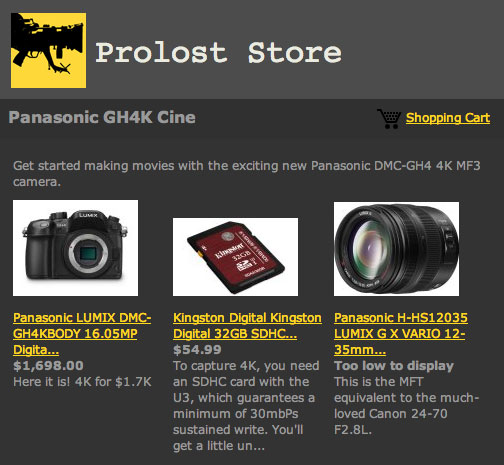Do You Want to be a Grown Up?
 Tuesday, October 12, 2010 at 8:29PM
Tuesday, October 12, 2010 at 8:29PM It’s kinda fun doing things the wrong way.
You can buy a fancy slider (I did, I love my Glidetrack HD), or you can feel so much more clever and agile turning any tripod into a jib arm.
We’ve been having a lot of fun shooting with DSLRs, complaining the entire time about all the obstacles they present. Won’t someone come along and make a camera with a huge sensor, interchangeable lenses, and proper video features?
I’ve been a part of this complaining, but I don’t share the opinion of some that the challenge is easy, if only Canon or Nikon or whomever cared to rise to it. The line-skipping or binning issue is not simply a question of will or understanding — it’s an actual limitation of how fast data can be streamed off the back of the sensor itself. To pull a full 5616x3160 image off the 5D Mark II’s sensor every 24th of a second would likely require a much more expensive sensor and a method of dealing with the resultant heat. We can complain all we want, but we’re the beneficiaries of a glorious happy accident of “good enough” coupled with Canon’s years of experience hacking OK-looking movies off point-and-shoot sensors. The result is that we’re making sexy-looking video (just don’t look too close) with cameras that costs only a grand or two — and most of that cost is due to features we’re not even using.
Still, it seems to be obvious that what I predicted two years ago is true: It’s no longer OK for video camera manufacturers, whether they be Sony or Canon or RED, to make a video camera that doesn’t excite us emotionally. I added: Buttons and features and resolution charts just had their ass handed to them by sex appeal.
But can we have both? Panasonic says yes.
This is the AF100. A proper video camera that will presumably ace its test charts, and also sports a 4/3” sensor like the GH1 and GH2. Interchangeable lenses. XLR mic inputs. HDMI and SDI outputs. No aliasing. Waveform monitor and focus-assist peaking in the viewfinder. A viewfinder. Watch this video and/or read his detailed write-up — Barry Green does a much better job than I ever could of pimping this thing.
It’s easy to understand his enthusiasm — this is everything we’ve been wanting. Or is it?
When I tweeted about the availability of the AF100 for pre-order from B&H Photo, I got a couple of replies to the general effect of “but will the images hold up to those of the 5D?” Now, why would a person ask that? Obviously Panasonic has gone to great pains to emphasize that this is a camera for grown-ups, with no pixel binning or line skipping. They have repeatedly stated that their target is zero aliasing artifacts. Between this an all the other pro features of this camera, such as its focus and exposure aides and various gamma modes, there’s no reason to doubt that this camera will make superior images to the current crop of HDSLRs.
No reason? Oops, I meant to say three reasons. One artistic, one technical, and one marketplace reason.
First, the technical reason to doubt the AF100: its codec. The AF100 is an AVCHD camera. We’ve discussed this codec here before, and while opinions vary, few would argue that it is a professional codec. At 17mbps it cripples the GH1. At 24mbps, the maximum allowed by the format, will the images from the AF100 be “good enough?” That strikes me as a sad question to be asking about a $5,000 camera body with a mission statement of quality.
The marketplace reason has to do with the availability, cost and quality of lenses for the AF100, and how those issues meld with the camera’s unique features. A big part of the cost and advantage of a camera like the AF100 is sophisticated autofocus. Even with my Redrock Micro EyeSpy Deluxe rig and my Zacuto Z-Finder, I find shooting with my 5D and 7D to be laborious for the simple reason of focus. The idea that I could enjoy shallow depth of field with (occasionally, mind you) reliable, fingertip-on/off face-tracking autofocus is actually quite revolutionary. You might save enough money in follow-focus add-ons and blown takes that the AF100 could start looking less expensive than a kitted-out 7D.
But if you want to take advantage of this revolution, you must chose from Panasonic’s small selection of continuous-AF, video-optimized glass. Most of these lenses are zooms, and rather slow:
You can see where I’m going with this. The top reasons for a big sensor are light sensitivity and control over depth of field. But with these lenses, you’ll be hard-pressed to create a sumptuous, DSLR-like narrow-focus world.
Panasonic does offer a 14mm prime that’s F2.5, and an awesome 20mm pancake at F1.7. Here’s a shot made with the latter.
 Panasonic GF1, 20mm at F1.7. Photo by Josh Locker
Panasonic GF1, 20mm at F1.7. Photo by Josh Locker
Clearly with the right lens, Micro four-thirds is plenty big to create a shallow-focus look. But so far there’s only one or maybe two video-optimized lenses that offer this. Which might be fine for many users, who look at the Micro Four-Thirds format as an opportunity to collect abundant, adorable little speedy primes, or to use a PL adapter to mount gloriously fast cine lenses. But in doing so, you’re not only making an investment in glass that might start to feel out of proportion to the camera, you’re also back to manual focus, which means an abundance of expensive support gear.
This rambling point I’m making about lenses has one last nuance, and its a personal one that you may or may not share. One advantage of shooting video with the same DSLR that I use for stills is that I only ever have to buy one kind of lens. As a result, I buy them more freely, and I buy really nice ones. If I suddenly had to collect completely different lenses for stills and video, the sad fact is that I’d buy fewer of each — even though these adorable little Panasonic lenses are quite reasonably priced.
The last reason to doubt that the AF100 will impress us more than the 5D Mark II, the artistic one, is the biggest, and it relates directly to the lens issue.
Quite simply, we have tasted full-retard DOF, and it is good.
 Canon 5D Mark II, 50mm at F1.2
Canon 5D Mark II, 50mm at F1.2
With a 5D Mark II, its sensor double the size of a motion picture film frame, we can achieve cinematic focus at F4. We can get fetishistically shallow depth of field at F2.8. At F1.2, we can create abstract art in a Burger King. The insanely shallow DOF afforded by the 5D Mark II is the artistic solution to the camera’s numerous technical problems.
Buttons and features and resolution charts just had their ass handed to them by sex appeal.
So the question becomes, if you have a little sex appeal and you nail the buttons and features and charts, do you defeat the less expensive, double-duty camera with its wealth of gloriously speedy lenses and sex appeal dripping down its glistening magnesium-alloy body?
Not with an F4 lens you don’t.
So at long last, here’s the thing about the AF100. It’s the sensible solution. But we might not want to grow up and use it. It’s a compromise. Its sensor is slightly smaller than that of the 7D, which you may recall I also weighed in this sex appeal equation, and determined that it just barely passed. Meanwhile, in this corner, the AF100 — smaller sensor, slower lenses, a $5,000 invite to the “buy a bunch of new lenses” club.
At this point, you must be thinking, “Man, I thought Stu liked Panasonic, and here they built exactly what he’s been asking for. Why so grumpy?”
The truth is, I am thrilled that Panasonic made this thing. They do get it. And by all indications, this camera rocks. Did I mention that it shoots at arbitrary frame rates up to 60fps at 1080p? Including funky frame rates like 22fps, for those post-lasagna-lunch Kung Fu fight scenes? It’s a true filmmaker’s camera.
What it needs is a better codec and some sexier continuous-AF lenses.
That’s all, and it ain’t much. I mean think about it — if this thing shot to ProRes, it and a PL Mount would be a ghetto Alexa for a tenth the price.
Now if I don’t buy an AF100, you can’t take that as a poor review from me. I’m not a pro shooter. Not even a responsible adult. I like doing things the wrong way, especially when I’m trading technical accuracy for images that make me want to lick the screen.
But that’s just me. You’re rockin’ it Panasonic. You’ve begun the flow of sex appeal into the world of proper video cameras. Please don’t stop though, you’re not quite done.
 Stu
Stu
Here’s some footage from a pre-production model. This is shot using an external recorder and Zeiss PL-mount lenses, so it represets a very expensive best-case scenario for this camera. Looks great, and how funny that it features someone using a Canon DSLR — to shoot stills.
Panasonic AG AF-100 01/02 evaluation footage by CREWS.TV from Yves Simard on Vimeo.

















